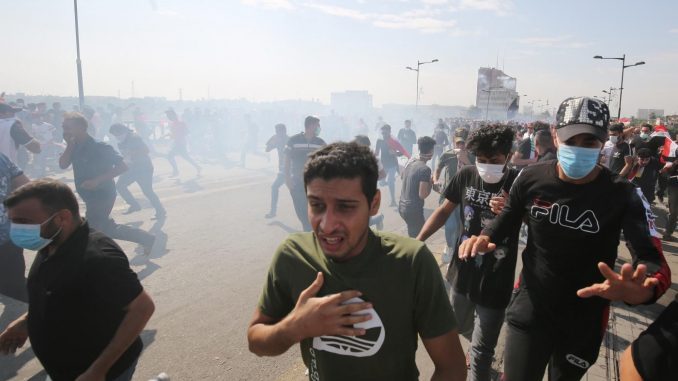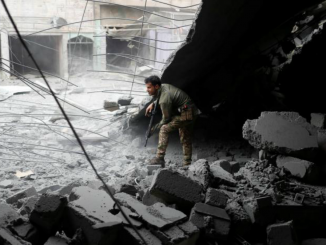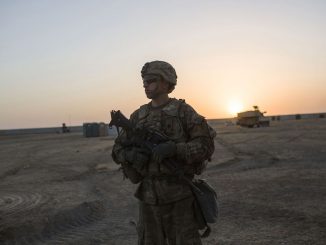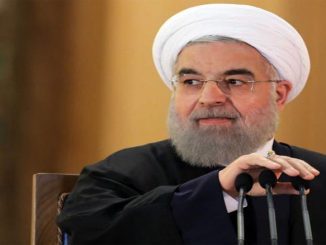
Iraqi Human Rights Commission says those killed appeared to have died after being hit by tear gas canisters
At least two demonstrators were killed in Baghdad on Friday morning as Iraq’s highest religious authority urged against “chaos” ahead of major protests across the country, reported the Middle East Eye..
The semi-governmental Iraqi Human Rights Commission said the demonstrators appeared to have died from wounds sustained when they were hit by tear gas canisters, adding to the scores of protesters killed since anti-government protests began in early October.
“Two demonstrators died, with preliminary information indicating they were hit in the head or face by tear gas canisters,” said Ali Bayati, a member of the Commission.
Medical sources told Reuters that more than 350 people were wounded as Iraqi security forces used tear gas and stun grenades to repel crowds marching towards the capital’s heavily fortified Green Zone.
The incident marks a renewal of the anti-government protests after a pause for the Arbaeen religious holiday.
The protests began in the early morning as about 1,000 people, some of whom had camped overnight in Baghdad’s Tahrir Square, marched towards the city’s fortified Green Zone, which houses government buildings and foreign embassies, when they were stopped by security forces.
By the afternoon the numbers had swelled to engulf all of Tahrir square and much of the surrounding area. Security forces responded with tear gas and stun grenades, attempting to disperse the protests.
Outside the capital, protesters in the city of Samawa in southern Muthanna province torched the regional headquarters of the Hikma political party and the Asa’ib Ahl al-Haq militia.
Video released on social media also appeared to show protesters breaking through barbed wire and storming the Muthanna Governorate building.
Another video appeared to show demonstrators setting fire to a local government building in the city of Nasiriyah in Dhi Qar province.
Protests also took place around the rest of southern Iraq, including Najaf and Wasit.
‘The people want the fall of the regime’
Salam Kashkal, one of the protesters, had camped out at Baghdad’s Tahrir Square overnight.
He and other demonstrators chanted “the people want the fall of the regime” and other slogans reminiscent of the 2011 Arab Spring protests, as they dodged tear gas.
Kashkal said protesting was an obligation because he, like others, had no way to make a living.
“I have nothing. I swear to God, I only have this,” he told MEE, waiving 2,500 Iraqi dinar (about $2 USD) in the air.
“Everyone is jobless.”
Many of the protesters waved Iraqi flags, as did some of the security forces surrounding them, in an apparent show of solidarity.
The spirit was patriotic, as people chanted “with spirit and blood, we sacrifice ourselves for Iraq.”
In Tahrir Square, police patted down people several blocks away before allowing them into the protest area. Most of the demonstrators were men, but some women showed up as well. Suad Izz al-Din was one of them.
“This government is not a government,” she told MEE, holding an Iraqi flag. “No salaries, no state, no nothing.”
One in five people lives in poverty in Iraq and youth unemployment sits at around 25 percent, according to the World Bank.
The rates are staggering for OPEC’s second-biggest oil producer, which Transparency International ranks as the 12th most corrupt state in the world.
Previous demonstrations had seen the government restricting internet access, which prevented information on the protest from filtering out.
As of Friday afternoon, however, a blackout had not been imposed in the capital.
One Baghdad-based online activist (who did not want his identity revealed) told MEE his group – named #IraqiRevolution on Twitter – were calling for a root and branch transformation of the Iraqi political system.
“Not just our group – the main demand for all of the demonstrators is to change the whole government and ban all the political parties involved in the government since 2003,” he explained.
“They are all corrupted, loyal to other countries, Iran, Saudi Arabia, USA.”
‘Chaos’
Ali al-Sistani, the highest Shia religious authority in Iraq, urged protesters during his Friday sermon to use “restraint” and prevent the demos descending into “chaos”.
The afternoon could see a major development, though, when many are expecting supporters of Muqtada al-Sadr – an influential cleric who controls the largest parliamentary bloc – to take to the streets.
Diyari Salih, a specialist in political geography at Al-Mustnasiriya University in Baghdad, said although he did not believe that Friday would see a repeat of the violence seen at previous demonstrations, there was a potential for clashes between armed Sadr supporters and members of the largely Iran-backed Hashd al-Shaabi militias.
“This is the worst-case scenario for how things might negatively develop – thus, Iraqi political parties must reach a quick settlement on this crisis,” he said.
It is not clear what effect the protests will have.
The government of Prime Minister Adel Abdul Mahdi has promised to make reforms. Kashkal said he was somewhat hopeful that the country will change.
“God willing,” he said on the prospect of reform. “I need rights.”



